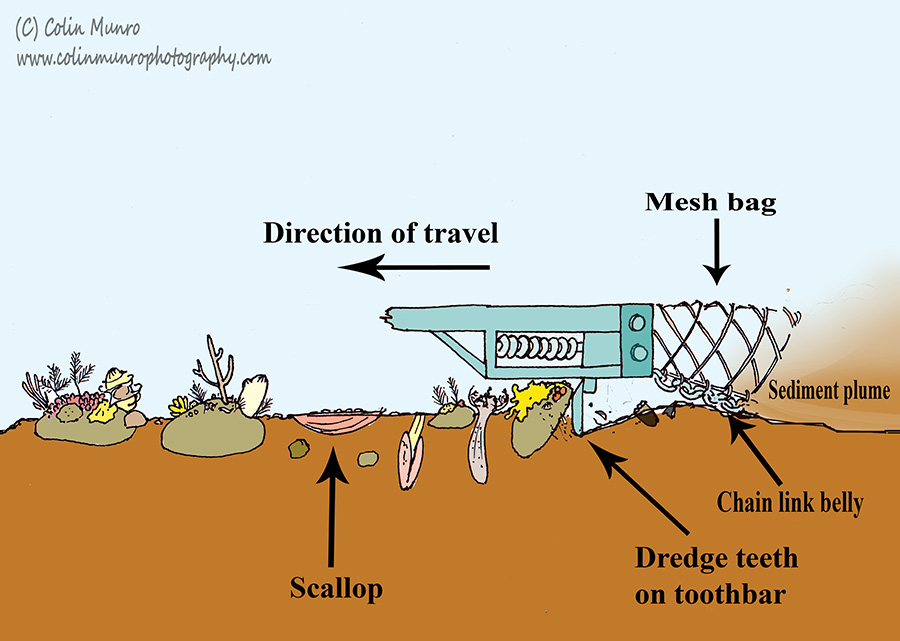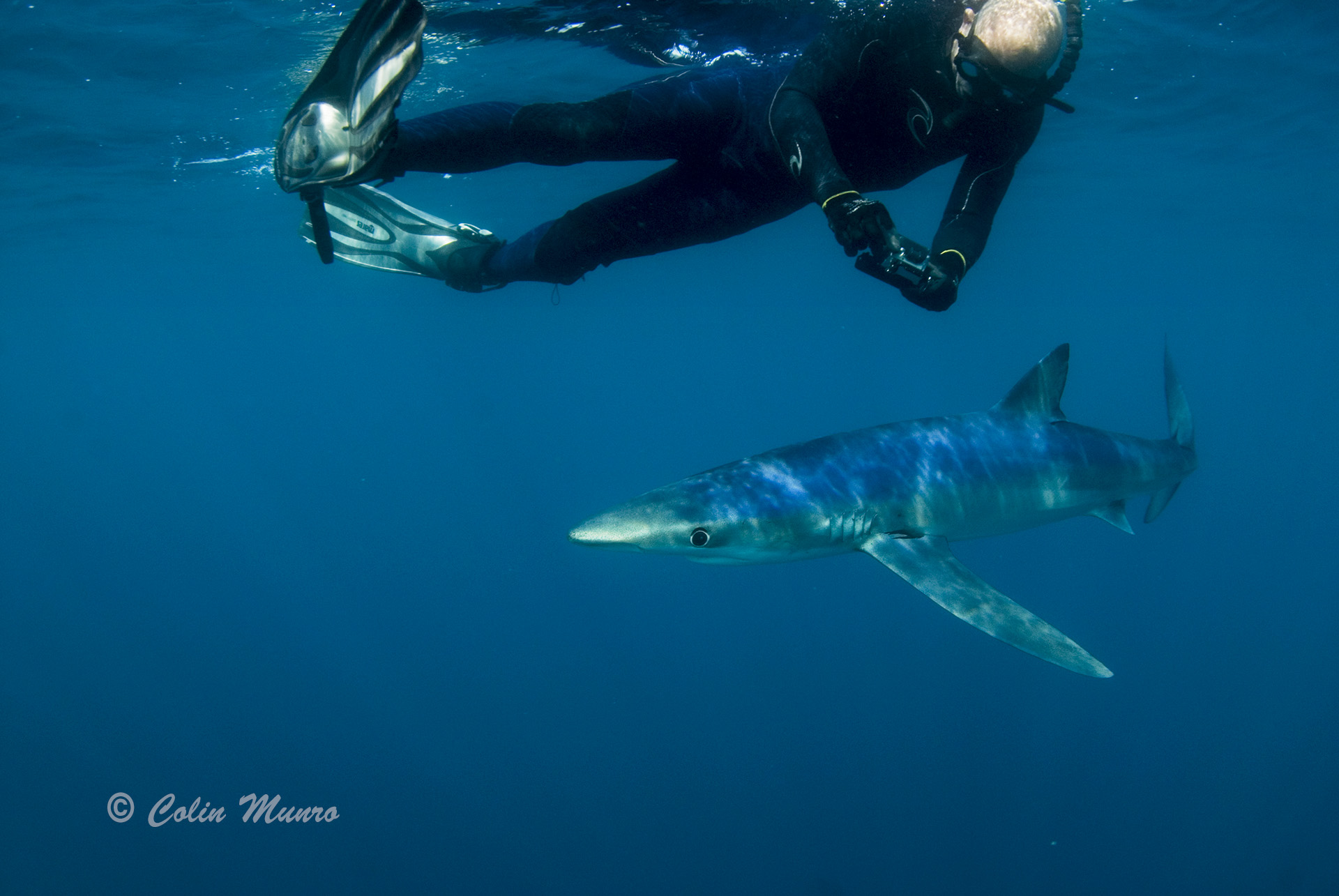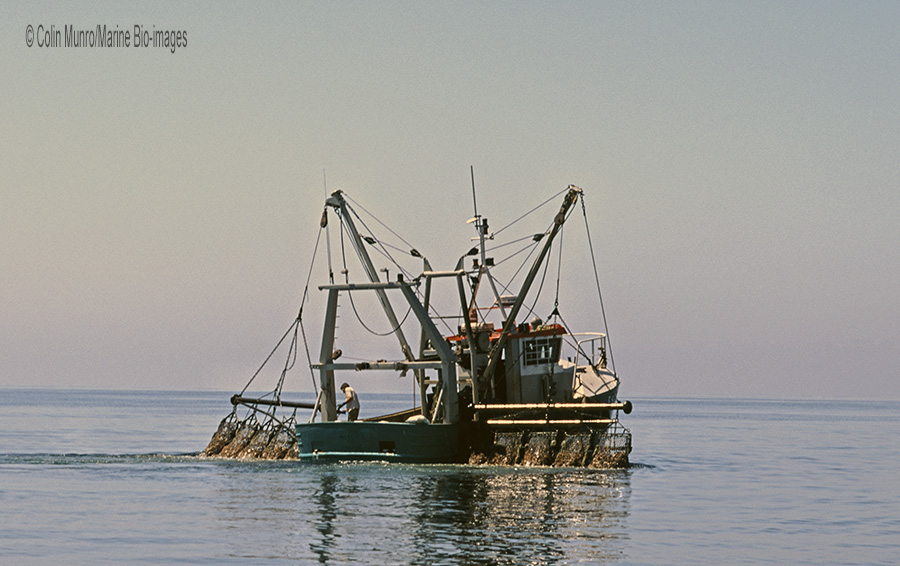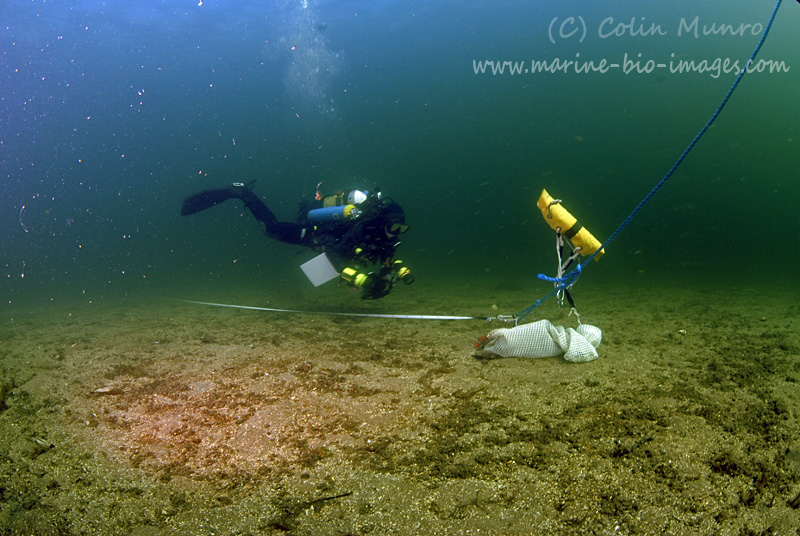Rapture of the Deep

Nitrogen narcosis can be a real problem for working divers breathing air at depth
Many years ago, I was diving off the west coast of Scotland with a group of friends. Our planned dive for that morning was a deep wall dive. I was paired up with a new diver to our group, relatively inexperienced but who been trained by our group leader who was confident of her abilities. Despite initial concerns, I was persuaded she was ready for a comparatively advanced dive like this. We agreed we would stay within no decompression stop limits, head straight down to 50m, and begin our slow ascent back up the wall. Allowing for our descent time, this would give us no more than a couple of minutes at 50m, but that was fine as the main purpose of the dive was to enjoy the marine life on the wall as we ascended. Buddy checks were completed, on the skipper’s signal we jumped off the dive boat, swum the short distance to the edge of the wall and began to descend. As we dropped steadily down, I continued to check on my dive buddy; she appeared relaxed and signalled all was fine. At around 46m we slowed, and I signalled to stop at just over 49m. After again checking all was okay I re-checked my dive computer; with one minute no stop bottom time remaining, I signalled for us to start ascending and my buddy confirmed. We rose about a metre together, but then my buddy stopped ascending. I dropped back down, made eye contact, signalled okay – which was confirmed – and again signalled up. After ascending maybe 30cm, my buddy again slowed and stopped. A second time I dropped back down, checked all was okay and signalled up, pointing to my dive computer and indicating we needed to keep moving. This seemed clearly understood, but as I ascended my buddy began to slowly descend. Dropping back down for a third time I decided it was time for positive action. We were over our planned maximum depth and over our no-stop time. I firmly grasped the collar of her buoyancy jacket, squirted a little extra air into my own and gave a little kick to start us moving. We continued up like this until we had ascended to around 30m depth and were back well inside our no-stop time. We then continued with our dive as planned. Once back on the surface, aboard our dive boat, my buddy was far from happy with me. Why had I spoiled the dive, grabbing hold of her like that, she wanted to know. It quickly became apparent that she had no memory of our start-stop ascent, or awareness that she had started to re-descend to beyond 50m. It took several minutes explaining and examining our computers’ dive log to convince her.
It is a well-known fact among divers that their ability of to recall observations made during a dive is worse than their recall of similar observations made while on land. Part of this appears to be due to having gather data underwater, then recall it in a completely different environment (dry land). That this can be a problem was demonstrated in a classic experiment by two British psychologists at the University of Stirling in Scotland, Duncan Godden and Alan Baddeley, back in the 1970s (Godden and Baddeley, 1975). Using volunteers from two local Scottish Sub Aqua clubs (including the Stirling University club) they had them recall words learned underwater, and words learned on land. Interestingly they found that words learned underwater were recalled less well on land (than if they had been learned on land) but were recalled equally well underwater as words learned and recalled on land. But this change of environment is not the entire reason. When diving on deep walls, recording species, I, and many other marine biologists I know, have had the experience of not being able to recall the name of a species we know well, when we are at depth (i.e. below 30 metres). Yet the name will suddenly pop in to our heads as we ascend to shallower depth. I have often resorted to drawing little sketches of the species on the side of my writing slate; ten metres shallower the scientific name would miraculously come to me, and I could replace the drawing with a proper name. In fact, I was merely demonstrating a known phenomenon. Experimenting with divers in recompression chambers. In 1975, Canadian reserachers Barry Fowler and Kenneth Ackles found that memory recall of previously learned words was disrupted under hyperbaric air conditions equivalent to significant depth. This, we know, is due to the narcotic effect of the nitrogen component of air. As depth, and so pressure, increases, so does the partial pressure of the 79% nitrogen in air, gradually introducing the effects of nitrogen narcosis.
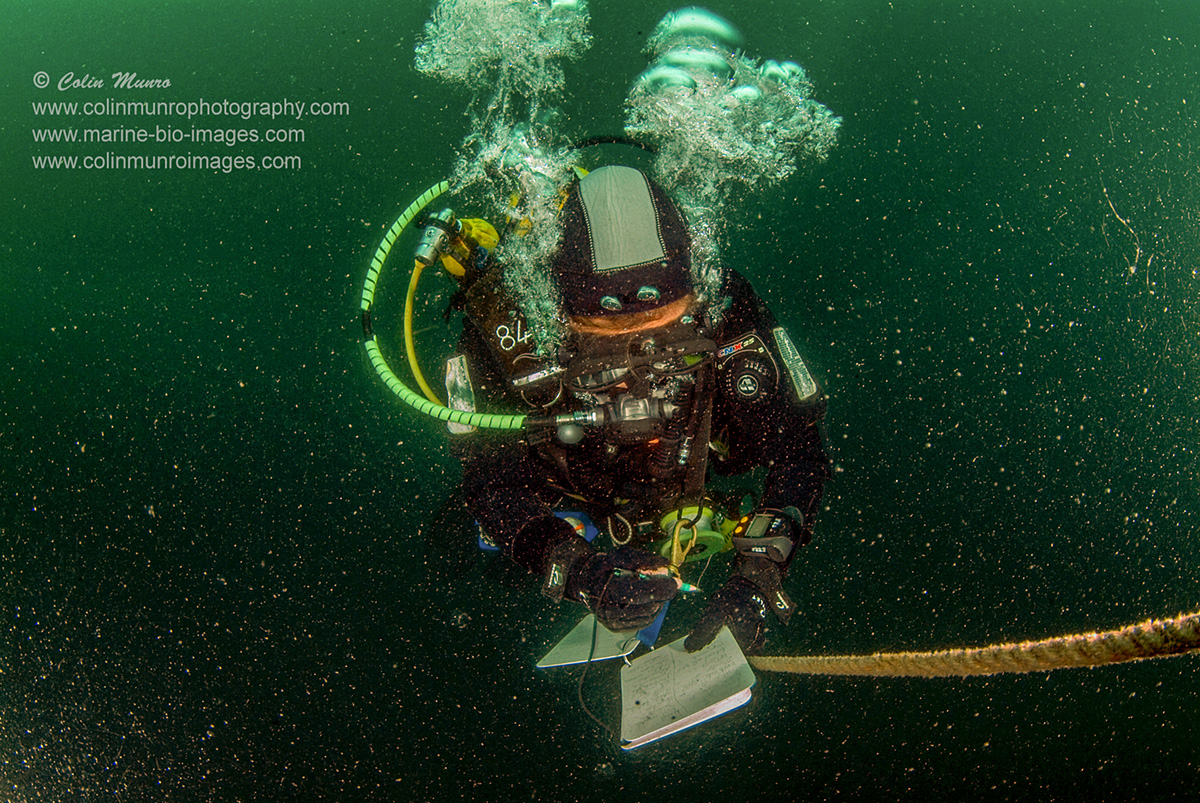
Scientific diver Kat Brown writes up notes on a writing slate as she ascends at the end of a dive.
The term l’ivresse des grandes profondeurs, translated to English as rapture of the great depths, has been credited to Jacques Cousteau, after his and Fredric Dumas’s vivid accounts of diving to over 200 feet (60 metres) in occupied France during WW2. Through his hugely popular book, and later film, The Silent World, Cousteau made the wider public aware of the ‘rapture of the depths’, but despite what you will read in many popular articles and some textbooks, it was not Cousteau that discovered the narcotic effects of breathing elevated levels of nitrogen.

The Silent World, by jacques cousteau and Frederic Dumas (1953).
Through its use as an anaesthetic, nitrogen’s narcotic effect was recorded as far back as 1799 by the Cornish chemist Humphrey Davey. Creating nitrous oxide by heating ammonium nitrate crystals, he collected the gas in a silk bag, from which he would then inhale, describing the sensations as ‘sublime emotion connected with highly vivid ideas’, an experience he appeared to become rather addicted to, spending hours alone in his laboratory inhaling large amounts of the gas. Fortunately, he maintained his scientific rigour and carefully described the effects (Davy H. Researches, chemical and philosophical, chiefly concerning nitrous oxide, or dephlogisticated nitrous air, and its respiration, 1800). Around 100 years later, German pharmacologist Hans Meyer and British physiologist Charles Overton independently, in 1899 and 1901, developed what is now known as the Meyer-Overton theory, linking the anaesthetic potency of gases (including nitrogen, but also others) to their solubility in lipids. In 1906 British Navy captain Guybon Damant dived to 64 metres in Loch Striven in West Scotland, setting a World record for the deepest dive outside a diving bell. This dive was conducted as part of Damant’s collaboration with Scottish scientist John Scott (J.S.) Haldane when the latter was working towards developing the World’s first diving decompression tables for the Royal Navy. Fortunately for Damant, most of Haldane’s experiments were conducted on goats, though he wasn’t above experimenting on himself or his son.

John Scott Haldane in 1910. Source Wikipedia under Creative Commons License (photographer unknown).
The following year Damant went on to become the Royal Navy’s Inspector of Diving and in 1917 he led the salvage operation on the SS Laurentic, a British ocean liner that had struck mines and sunk, with 43 tons of gold on board, in January of that year. His interest in science did not dim however and in 1930 he published an article in the journal Nature, entitled Physiological Effects of Work in Compressed Air. The bulk of the article dealt with the effects of physical work on nitrogen absorption and release (and the potential for decompression sickness to occur) drawing on his experience of operations such as the Laurentic salvage, and ‘dry’ experiments done using a Siebe Gorman Davis hyperbaric chamber. However, in an interesting aside, Damant described how some divers, during deep hyperbaric chamber dives (equivalent to over 300ft (91m) depth) would become ‘abnormal mentally, or emotionally’ under high pressure, yet have no memory of it upon return to atmospheric pressure. With wonderful British reserve, Damant described the discovery of this phenomenon as ‘unexpected and rather awkward’ and only a few lines were devoted to it in the article. Though he and his co-workers were unaware of the cause of these changes, he was undoubtedly describing nitrogen narcosis.
As a young military diver in the late 1970s, I was a beneficiary of much of this early research. The first dive tables I dived on were Royal Navy Physiological Laboratory (RNPL) 1972 tables, developed by the laboratories’ superintendent Val Hempleman, building on the original work of Haldane and Damant. I learned these at the British Army’s diving school in Marchwood, near Southampton, England. Classroom learning was a bit of a hit and miss affair, as much of the training was devoted to physical endurance and discipline. One of the favoured punishments for minor misdemeanours was having to wear a latex rubber diving hood during classes. Hot, uncomfortable and humiliating, it also meant you heard very little, so left the classroom in a blissful haze as ignorant as you had entered. Uncomfortable as it was however, this punishment was preferable to the alternative, carrying a four-foot length of telegraph pole on your shoulder as you jogged between classes.
Ongoing practice and training is very much part of any military regime. Once established as part of the regimental dive team in northern Germany our training continued in lakes, flooded quarries and industrial rivers, the blacker water the better as far the Army was concerned. As part of this training we sometimes travelled to Kiel, to dive in the Baltic, generally in mid-winter when a thin film of ice covered the sea.

A rather younger version of me preparing to dive, Keil, North Germany, 1977-78.
During one of these visits I, along with about nine of my fellow divers, were allowed to complete a chamber dive in the nearby German military’s recompression chamber. We were blown down to 70 bar pressure (equivalent to 60 metres depth) on air. This resulted in much hilarity and laughter among my equally young and inexperienced colleagues. I however, felt completely clear headed and, watching my friends with mild amusement, was convinced that they were suffering from marked nitrogen narcosis (true) and that I was not (not quite so true). We were then asked to complete a short and simple arithmetic test, on sheets of paper handed out by our instructor. This was indeed very simple, consisting of a drawing of a lake and several small dinghies and questions such as: how many dinghies are in the lake; how many are beside the lake; how many dinghies are there in total? And so on. Imagine my shock, upon receiving my test paper back after exiting the chamber, to find that I had scored the lowest mark of anyone, with over 50% wrong. Yet I had been convinced that I was totally unaffected and clear headed. This was a salutary lesson for me. Nitrogen narcosis can often leave us believing we are performing as efficiently and thinking as clearly as if we were on dry land when in fact we are anything but.
Fast-forward a couple of decades, and I found myself running a scientific study looking at the population dynamics on an offshore reef off the south coast of England. The study reef was in 27-29 metres, so within the depth range where subtle effects of narcosis start to occur. It was also an ideal depth for the use of nitrox, air where the oxygen percentage is increased and the nitrogen percentage lowered. So I reconfigured our filling station to mix nitrox, and this became the gas of choice for most dives. The prime reason was the extended bottom time available on nitrox 32 or 36 (i.e. 32% or 23% oxygen, as opposed to 21% air) at this depth, which vastly improved our efficiency. It meant that around double the amount of work could be completed in one days’ diving compared to the same operation breathing air. But I am also of the opinion that the quality of our data improved because of this switch. I personally felt more clear headed during a dive and less fatigued following a days’ diving, despite being in the water far longer. This was not, of course, a controlled experiment, but there was definitely a sense among us that we were sharper and operated more efficiently when breathing nitrox. Thinking back to the chamber dive arithmetic test I performed as a teenage army diver, the key point is that I was completely unaware that I was being affected by narcosis and that my calculations were so wrong. For so much scientific diving data collection, where reliance is placed on divers counting, measuring, or otherwise visually assessing, and then recording these data on underwater writing slates, the potential for error is, in my opinion, significant when you are working (breathing air) below 25 metres depth.

Working in dark and turbid water at depth appears to increase our susceptibility to nitrogen narcosis. Scientific diver lexie Munro working on our seafan study at around 28 metres. 2000.
Deeper than 34 metres the situation becomes more complex. The benefits of nitrox are limited, as the correspondingly increased partial pressure of oxygen (PPO2) becomes the limiting factor (e.g. nitrox 32 gives a PPO2 of 1.4bar at 34 metres depth, 1.4bar being considered the safe maximum to avoid the potential effects of oxygen toxicity). For deeper depths the gradual replacement of nitrogen by other inert gases (most commonly helium) is frequently used. Controlling the oxygen levels to prevent toxicity, and reducing decompression penalties by utilising inert gases that have faster saturation and desaturation speeds, are the main goals for these alternative breathing gas mixtures, but limiting the narcotic effects (at depth) of the breathing mix is also an essential consideration. Indeed, calculating the equivalent narcotic depth (END), i.e. the depth at which the same level of narcosis would be experienced if breathing compressed air, is part of the process of determining the most suitable mix for deep dives. Thus helium is the nitrogen replacement gas of choice not only because it has the fastest desaturation rate of all inert gases (apart from hydrogen which is generally discounted due to its flammability and risk of explosion) but also because it has the lowest narcotic effect of all tested noble (inert) gases.
So what exactly causes nitrogen narcosis? Among the first studies designed to measure and investigate the effects of high pressure nitrogen were those of Dr. Peter Bennett, working at the Royal Navy Physiological Laboratory in the late 1950s and early 1960s (Bennet would go on to become the first CEO of the DAN network, and to develop trimix for deep SCUBA at Duke University). But back the late 1950s Bennett was head of a small team working on inert gas narcosis at the Royal Navy Physiological Laboratory in Portsmouth. Here he and colleagues demonstrated that breathing air at depth (trialled at 30 and 60m) the normal electrical activity of the brain altered. At atmospheric pressure, when asked to perform mental arithmetic or other complex tasks, Alpha waves (associated with restful states of mind) will normally stop as the brain fires in to action. But at both 30m and 60m this did not occur. As they described it, the Alpha-blocking response was stopped. More interestingly, what varied with pressure was not the severity of the response, but the time lag before it occurred. So typically Alpha-blocking stopped after about 3 minutes at 7bar abs. pressure (60m equivalent depth) but took 12 minutes at 4bar abs. (30m equivalent). Having the men perform arithmetic test at 45m equivalent pressure resulted in a 12% increase in incorrect answers (Bennett and Glass, 1960). Some of the volunteer subjects were switched to breathing oxy-helium mixes during the chamber dives. With these it was found that the normal Alpha-blocking returned within a few minutes, demonstrating that nitrogen at high pressure was the cause of these changes.
This early work of Bennet’s was taken up by Ralph Kiessling of the U.S. Navy Experimental Diving Unit, and Clinton Maag at US Office of Navy Research. They confirmed that divers’ ability to complete complex tasks was significantly impaired as depths as shallow as 30 metres, and the more complex the task the greater the degree of impairment. However, their data indicated that there was no real time lag between arriving at depth and impairment setting in. This suggested that the delayed Alpha-blocking detected by Bennet and Glass was maybe not the driver of the effects of narcosis, but simply another effect. It is often said that divers can learn to reduce the effects of narcosis. Before conducting deep dives, we will conduct a series of work up dives to prepare us. But does that actually reduce the effects of narcosis? Work done by Hamilton, Laliberté and Fowler in the mid-1990s suggest that we simply learn to cope with the effects rather than reduce them, in particular reaction time did not improve over time. In recent decades the concept of nitrogen absorption into the bi-lipid layer of neural cell membranes, disrupting communication between nerve cells.
Of course nitrogen is not the only inert gas used in diving. Helium replaces nitrogen in deep, technical diving, and hydrogen and neon have been used to replace nitrogen in experimental dives. The level of narcosis induced varies markedly between these gases, and it correlates well with their solubility in lipids, thus supporting the bi-lipid layer absorption theory (e.g. hydrogen is less soluble than nitrogen, but more soluble than helium; hydrogen is also less narcotic than nitrogen, but more narcotic than helium). This theory has been popular for a long time; essentially a refinement of the Meyer-Overton theory developed at the start of the previous century and later refined as the ‘critical volume theory’. This proposes that gas molecules accumulate in the cell membrane lipid layers, causing it to swell and distort. It is not, however, the only theory in in town. Double Nobel Prize winner Linus Pauling (so clearly someone we should pay attention to) developed an aqueous phase theory that would require several pages to attempt to explain, so I won’t. More recently the ‘protein theory’ where inert gases bond to protein sites through as yet unclear mechanisms is gaining traction as supporting evidence grows. There has also been some fascinating work recently demonstrating the suppression of release of certain neurotransmitters, in particular dopamine, under high partial pressure of nitrogen. Studies conducted on rats (Lavoute, et al. 2012) demonstrated that a small number of repeated exposures to narcosis inducing levels of nitrogen at high pressure appeared to cause long-lasting changes in the brain’s neural pathways and neurotransmitter receptors. The implications for divers is not yet known, but it raises the possibility that the effects of regularly getting ‘narked’ may not be confined to ones that disappear as soon as you surface. Bosco et al (2023) found that chamber dives to equivalent 48 metres seawater, while induced marked narcosis effects on study subjects, also produced significantly lowered circulating levels of glutamate (the major excitatory neurotransmitter in the brain), dopamine and BDNF (Brain-derived neurotrophic factor). BDNF influences a wide number of processes within the brain, playing an important role in neuronal survival and growth, and serves as a neurotransmitter modulator. The study found that these levels remained low at least ten minutes after the divers had returned to surface pressure.
For longer term effects, without complete understanding of the mechanism, it is not possible to differentiate between effects due to narcosis-inducing changes and effects due to other factors such as micro-bubble formation during decompression. In recent years a number of studies have demonstrated lowered cognition abilities correlating to having conducted a large number of dives (e.g. Coco et al, 2019) and evidence of micro-lesions on the myelin sheath (essentially the insulating layer around nerve cells). Whether this is due to changes in brain chemistry, microbubbles, or both (or an as yet unknown mechanism) remains an open question.
Nearly 70 years on from Cousteau and Dumas’s Silent world, 90 years since Damant’s nature article, and 320 years on from Davy’s treatise, we still do not really understand the biochemical and physiological changes that cause nitrogen narcosis.
References
Bosco, G., Giacon, T.A., Paolocci, N. et al, 2023. Dopamine/BDNF loss underscores narcosis cognitive impairment in divers: a proof of concept in a dry condition. Eur J Appl Physiol 123, 143–158 (2023). https://doi.org/10.1007/s00421-022-05055-6
Coco M, Buscemi A, Perciavalle V et al, 2019. Cognitive deficits and white matter alterations in highly trained scuba divers. Front Psychol 10:2376. https://doi.org/10.3389/fpsyg.2019.02376
DAMANT, G. C. C. 1930. Physiological effects of work in compressed air. Nature (Lond.) 126: 606–608.
Fowler B, Ackles KN. Effect of hyperbaric air on long-term memory organization and recall. Aviat Space Environ Med. 1975;46(5):655‐659.
Godden, D. & Baddeley, A.D., 1975. Context dependent memory in two natural environments on land and underwater. British Journal of Psychology, 66, 325-331.
Hamilton K, Laliberté MF, Fowler B. Dissociation of the behavioral and subjective components of nitrogen narcosis and diver adaptation. Undersea Hyperb Med. 1995;22(1):41-49.
Kiessling, R. J., & Maag, C. H. 1962. Performance impairment as a function of nitrogen narcosis. Journal of Applied Psychology, 46(2), 91–95.
Lavoute C, Weiss M, Risso JJ, Rostain JC. Mechanism of action of nitrogen pressure in controlling striatal dopamine level of freely moving rats is changed by recurrent exposures to nitrogen narcosis. Neurochem Res 37(3): 655-664, 2012. doi: 10.1007/s11064-011-0657-1.










